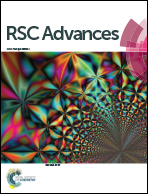The effect of ring sizes and alkali metal cations on interaction energy, charge transfer and nonlinear optical properties of crown ether derivatives†
Abstract
In 2003, a novel compound 2 containing the benzo-15-crown-5 moiety was synthesized and described. In the present work, we have designed two compounds 1 (benzo-12-crown-4) and 3 (benzo-18-crown-6) on the basis of compound 2. Further, nine configurations N*M (N = 1, 2 and 3; M = Li+, Na+ and K+) are designed by the compounds 1, 2 and 3 complexing alkali metal cations. Density functional calculation is performed to investigate the effect of ring size and the nature of the alkali metal cations on the interaction energy, charge transfer and nonlinear optical properties. The results indicate that the interaction energy of N*M depends on both the ring size and the nature of the alkali metal cations. Moreover, the amount of net charge transfer is related to the diameters of the alkali metal cations. In addition, the calculated nonlinear optical properties reveal that compound 2 has the largest first hyperpolarizability among the three compounds 1, 2 and 3. However, the alkali metal cations give rise to different effects on the nonlinear optical properties. Significantly, the order of the first hyperpolarizability can be explained by the transition energy and the dipole moment variation within the two-state approximation.


 Please wait while we load your content...
Please wait while we load your content...